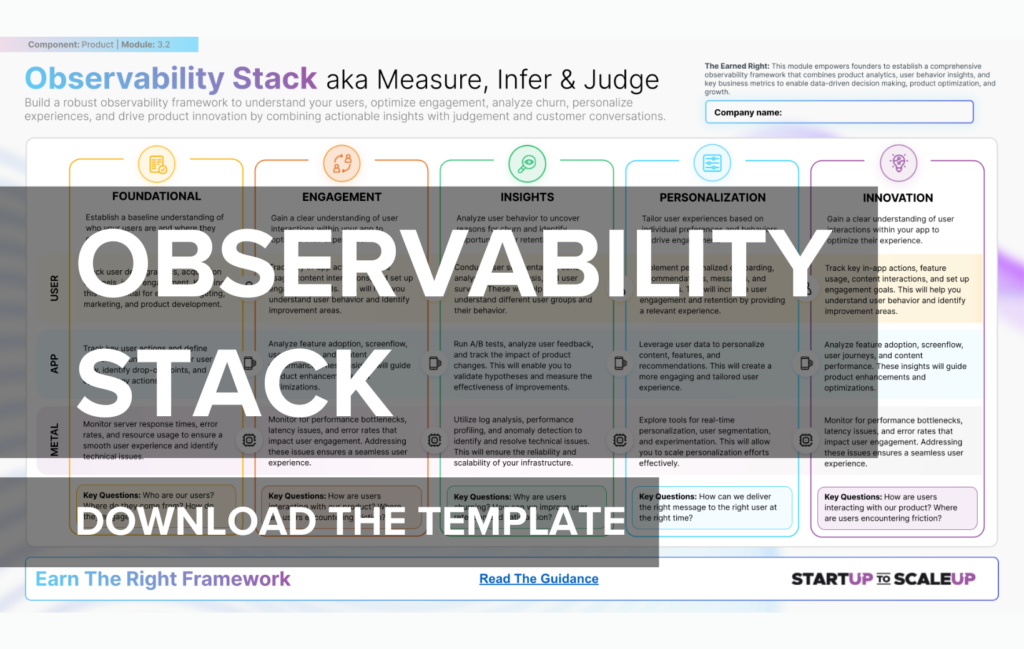How Can Startups Implement Effective Observability?
Why is observability crucial for startup success?
Observability is critical for startups because:
- Informed decision-making: It provides data to guide strategic choices.
- Product improvement: It reveals how users interact with your product and where they struggle.
- Performance optimization: It helps identify and resolve issues quickly.
- User experience enhancement: It provides insights to improve customer satisfaction.
- Resource allocation: It shows where to focus development efforts for maximum impact.
- Growth tracking: It allows you to measure and analyze your startup’s progress.
- Investor relations: It provides concrete data to demonstrate traction to investors.
Effective observability turns gut feelings into data-driven decisions, crucial for startup success.
How can startups set up comprehensive product analytics?
To set up comprehensive product analytics:
- Define key metrics: Identify the most important indicators of product success.
- Implement tracking tools: Use tools like Google Analytics, Mixpanel, or Amplitude.
- Set up event tracking: Monitor specific user actions within your product.
- Create user segments: Group users based on behavior or characteristics for deeper insights.
- Implement funnel analysis: Track user progression through key processes.
- Set up dashboards: Create visual representations of key data for easy monitoring.
- Establish regular review processes: Schedule time to analyze and act on the data collected.
Focus on collecting data that directly informs product decisions and measures business success.
What key metrics should startups track for product performance?
Key metrics for product performance include:
- User activation rate: How many new users successfully start using your product.
- Retention rate: The percentage of users who continue using your product over time.
- User engagement: Frequency and depth of product usage.
- Time to value: How quickly users achieve their first meaningful outcome.
- Error rates: Frequency of crashes or other technical issues.
- Feature adoption: Which features are being used and how often.
- Customer satisfaction: Measured through metrics like Net Promoter Score (NPS).
Regularly analyze these metrics to understand product health and areas for improvement.
How can founders use data to make better business decisions?
To use data for better decision-making:
- Establish a data-driven culture: Encourage team members to back proposals with data.
- Set clear objectives: Define what you’re trying to achieve before analyzing data.
- Use A/B testing: Test different approaches and let data guide your choices.
- Combine quantitative and qualitative data: Use both numbers and user feedback.
- Look for trends and patterns: Analyze data over time to identify meaningful shifts.
- Challenge assumptions: Use data to question and verify your hypotheses.
- Automate reporting: Set up regular reports to keep key metrics top of mind.
Remember, data should inform, not replace, human judgment in decision-making.
What tools are most effective for startup observability?
Effective observability tools for startups include:
- Google Analytics: For website and basic product analytics.
- Mixpanel or Amplitude: For in-depth product analytics and user behavior tracking.
- Sentry or Rollbar: For error tracking and debugging.
- New Relic or Datadog: For performance monitoring and infrastructure observability.
- Hotjar: For visual representations of user behavior (heatmaps, session recordings).
- Looker or Tableau: For data visualization and business intelligence.
- Segment: For centralizing and routing data to various tools.
Choose tools that integrate well with your tech stack and provide actionable insights for your specific needs.
How can startups balance data collection with user privacy?
To balance data collection and privacy:
- Be transparent: Clearly communicate what data you’re collecting and why.
- Get consent: Implement opt-in mechanisms for data collection.
- Anonymize data: Remove personally identifiable information when possible.
- Implement strong security: Protect collected data with robust security measures.
- Follow regulations: Adhere to laws like GDPR and CCPA.
- Provide control: Give users options to manage their data and privacy settings.
- Collect only what’s necessary: Avoid collecting data that doesn’t serve a clear purpose.
Prioritize building user trust through responsible data practices.
How can startups use observability to improve customer experience?
To improve customer experience through observability:
- Track user journeys: Analyze how users navigate through your product.
- Identify pain points: Use data to find where users struggle or drop off.
- Personalize experiences: Use behavior data to tailor the product to individual users.
- Proactively address issues: Monitor for potential problems and resolve them before they affect users.
- Measure feature impact: Analyze how new features affect user satisfaction and engagement.
- Optimize onboarding: Use data to refine the new user experience.
- Gather contextual feedback: Collect user feedback at key moments in their journey.
Use observability to create a continuous feedback loop for improving customer experience.
Implementing effective observability is about more than just collecting data – it’s about creating systems that provide actionable insights to drive your startup’s growth. Start by clearly defining what success looks like for your product and business, then identify the key metrics that will help you measure progress towards these goals. Implement a mix of tools that cover product analytics, performance monitoring, and user behavior tracking.
Remember to balance comprehensive data collection with respect for user privacy and regulatory compliance. Regularly review and analyze the data you’re collecting, and create processes for turning these insights into concrete actions. Encourage a data-driven culture across your team, where decisions are backed by evidence rather than just intuition.
By mastering observability, you’ll be able to make more informed decisions, improve your product more quickly, and ultimately deliver better value to your customers. This data-driven approach can give you a significant competitive advantage in the fast-paced startup world.
